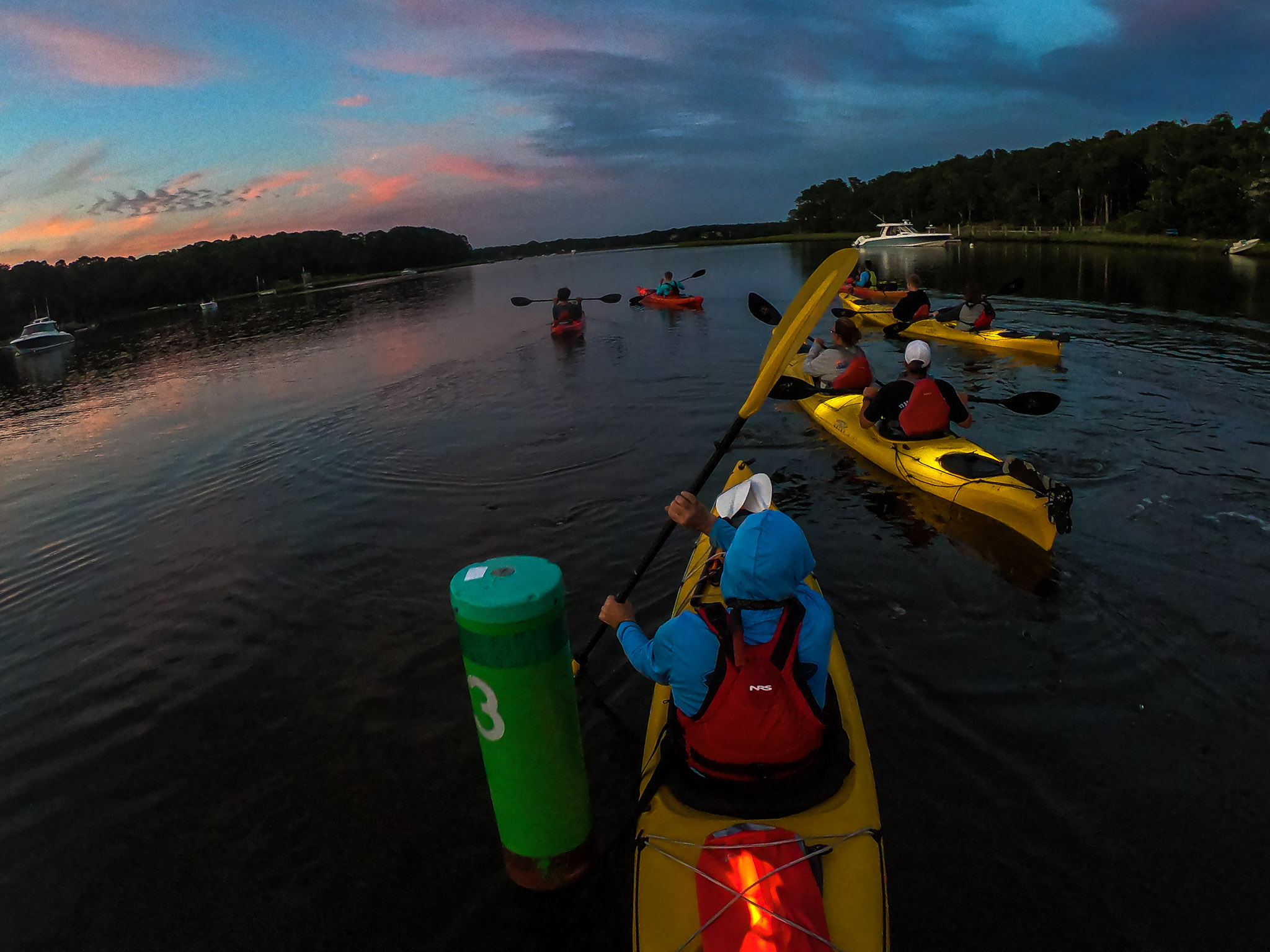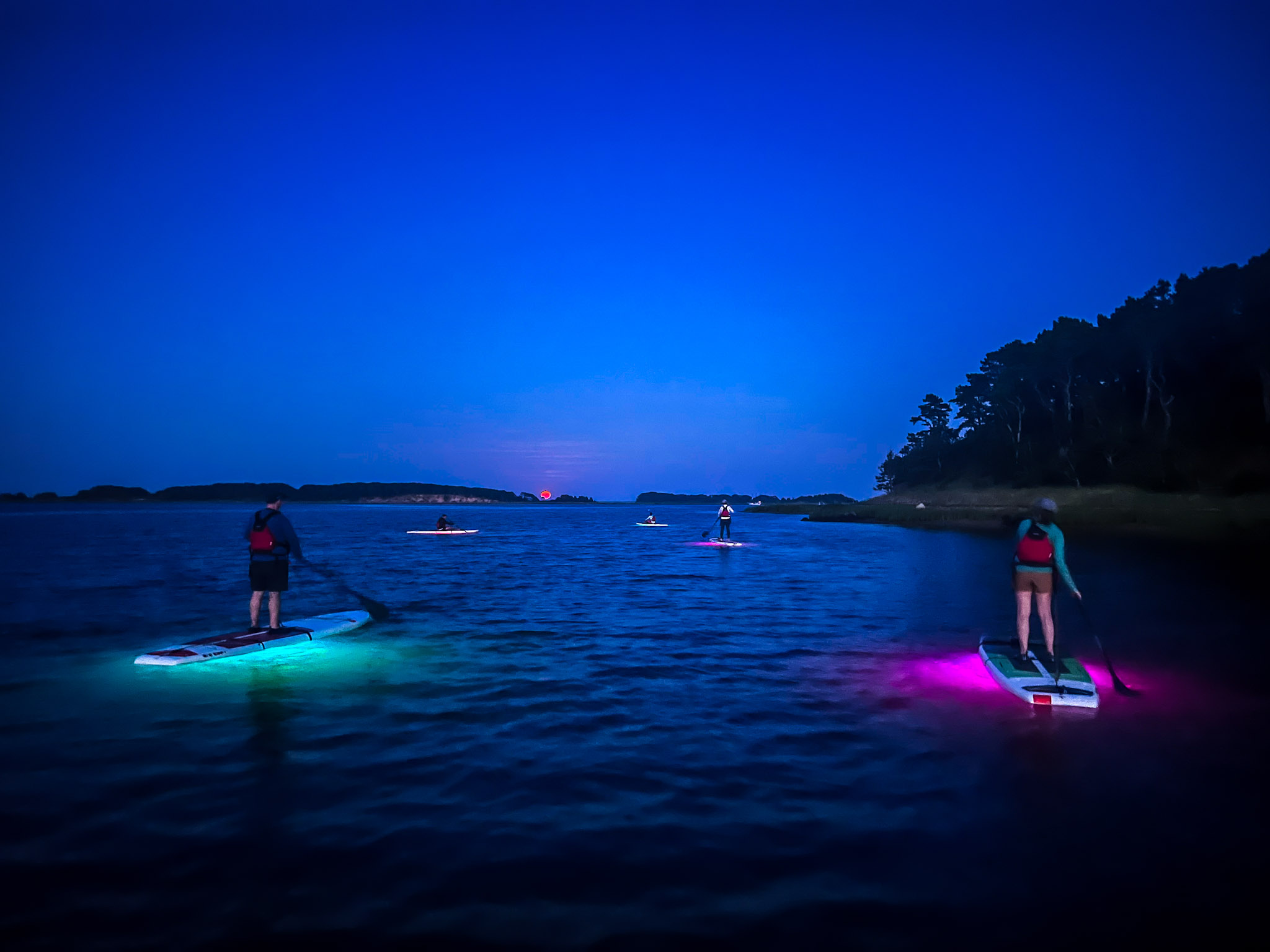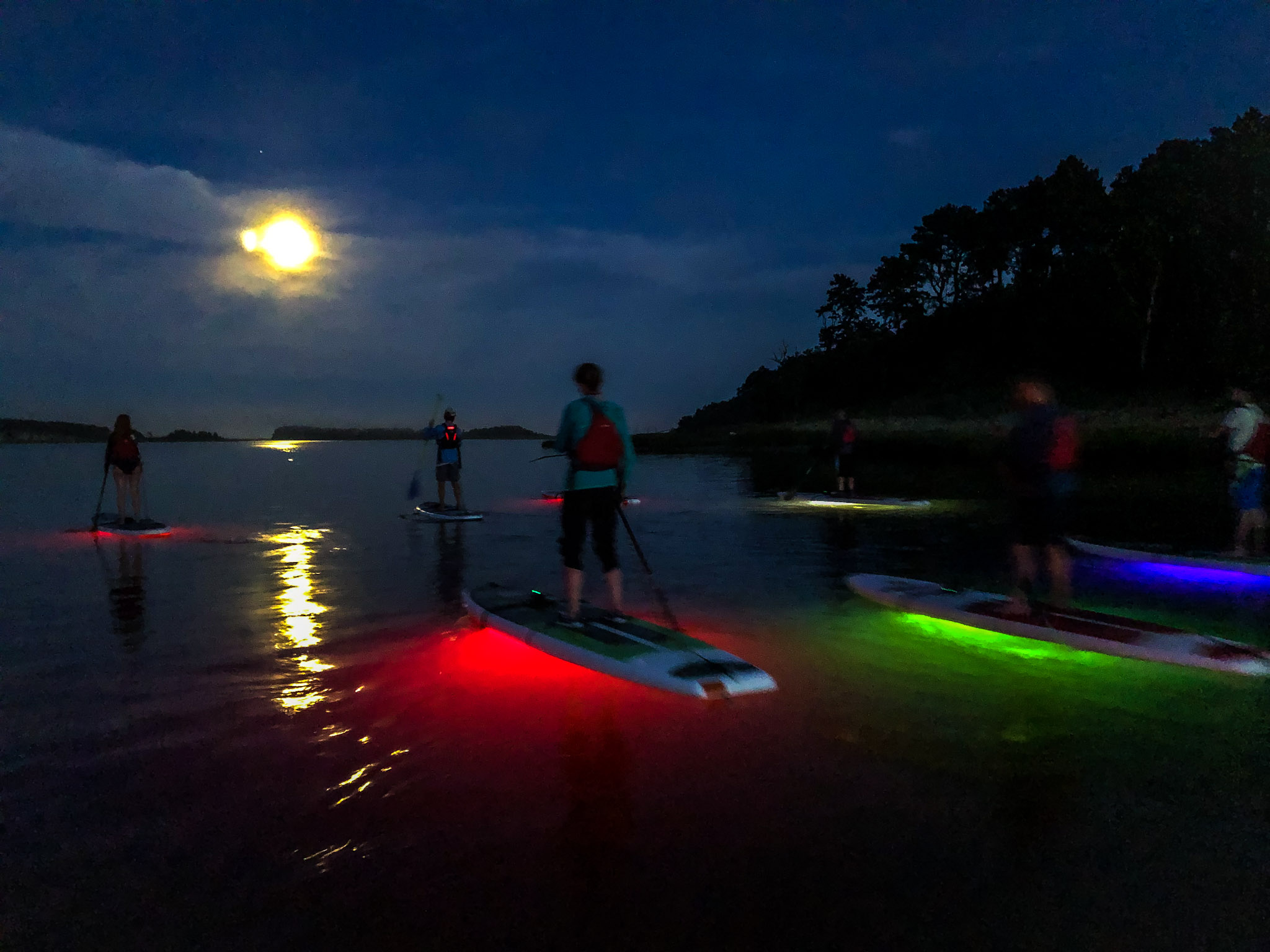The first time I paddled at night, I was utterly amazed—the stars, the solitude, and the intoxicating blend of silence and the intermittent noises of the night had me hooked. I’ve logged a lot of hours on the water in the dark since that first night paddle. In fact, I now find myself guiding nighttime paddleboard and kayak tours on a regular basis.
While paddling at night is an amazing experience, there are some things you need to know before you go. Here are 10 key tips for getting on the water for your first night paddle.

10 Considerations When Planning a Night Paddle
1. Carry the Essentials
At a minimum, when paddling at night you’ll want to wear a United States Coast Guard (USCG) approved personal flotation device (PFD), have a whistle on your person, and have the ability to show a light in time to avoid a collision.
2. Read the Rules
Rules and regulations regarding kayaking and paddleboarding—such as age restrictions, off-limit areas, and restrictions on when you’re allowed on the water—can vary depending on location. Familiarize yourself with the local laws and any applicable rules before hitting the water.
3. Know the Area
It goes without saying that paddling at night makes navigating difficult. Consequently, it’s extremely important to know the area where you’re paddling and have identifiable landmarks you can spot at night for direction and the location of launch and land points. Before heading out on a night mission, paddle the route during the day to familiarize yourself with markers that you can identify in the dark.
Early in my paddling career, I tried to cheat this step by taping glow sticks to my launch/landing point. Unfortunately, the tape didn’t hold and the night became more of an adventure than I bargained for. Another hard paddling lesson learned through experience.
4. Bring Navigation
Even ace navigators can get turned around and the best-laid plans can come unglued (or untaped, as above). A GPS track, either on a GPS app on your phone or a dedicated GPS device, is also a useful tool. Load your route in advance and use it to stay on course.
5. Light It Up
In addition to having a light on your body, lights on your boat/board are a must. Over the years, I’ve dialed in a lighting setup for kayaks and SUPs that maximizes visibility and experience.
Kayak Lights: Weather-resistant LED work lights are excellent for illuminating boats. The brighter the better—I favor 1,500-lumen lights and place one in the bow hatch and one in the stern hatch. Another trick is to put a light into a clear or light-colored dry bag. The dry bag diffuses the light, which makes it great for adding visibility to a craft (though less good for seeing your surroundings). Also, consider the color and material of your boat—plastic brightens better than composite, and colors like yellow and orange are easier to illuminate than deep reds and blues.
Paddleboard Lights: I’ve found that Nocqua Lights work great for paddleboards. They’re waterproof and rechargeable—meaning they’ll last for multiple night paddles. The lights also attach easily to a board. The stock straps work fine, but I use velcro straps to cut down on drag and the amount of debris they collect. The lights also change colors, which is a fun way to brighten up an evening.

6. Bring Backups
No one wants to carry more stuff than necessary on their boat or board, but it’s extremely important to have backup lights on board. In addition to the lights on my person and craft, I carry an extra battery as well as a backup flashlight and/or headlamp. Simply put, not having a light on the water is not an option.
7. Never Paddle Alone
Paddle with a partner even if you’re extremely familiar with a route. I can’t stress this enough, padding at night alone is a bad idea. Trust me, if something happens, you’ll want someone else with you—whether it’s a medical emergency, accident, or a minke whale breaching just behind your boat (like what happened to me last summer on a trip into Orleans’ Pleasant Bay).
8. Check the Weather
Before leaving shore, make sure to check the weather and keep a lookout for fog in the forecast. It’s hard enough to navigate at night and be seen by other boats in good conditions. Fog can make visibility even more muddled, and is especially dangerous if you’re paddling in an area with regular boat traffic. Paddling through the fog can also be scary, especially if you’ve recently watched Jaws.
9. Know and Stay Within Your Limits
When planning your night paddle, set a turnaround time, aim to stay close to shore, and have people on land who know where you are and when you intend to return. If a trip starts to feel uncomfortable or you feel like you’re pushing your limits, play it safe and head back to shore.
10. Choosing Your Craft
Whether on a boat or a board, paddling at night is an amazing experience, there’s something special about watching the moon rise or a meteor shower from the water. While both kayaks and SUPs are great for night paddling, they each provide unique experiences.
Kayaks keep you a bit warmer and dryer than an SUP. This isn’t a huge deal during the dog days of summer, but spring and fall nights can get quite cold, especially if you get wet. Paddling a kayak is also more intuitive than a SUP at night—it’s really not that different than paddling during the day.
SUPs put paddlers in an upright position, which allows them to see more clearly what is below them in the water. It’s really cool to watch fish swim under your board, so long as nothing too big swims underneath you! Light also seems to travel better from a SUP than a kayak, which provides paddleboarders an improved ability to see what’s happening around them. One thing to know about paddling a SUP at night is that the movement of the board and water can be disorienting and increase your odds of an unexpected swim.

Have you paddled at night? If so, share your experience or favorite tips for getting on the water in the dark. If you haven’t taken a night paddle but are interested, just remember to respect the water and take the above-mentioned steps to ensure your safety.
Luke Foley
Luke Foley is passionate about discovering and sharing hidden local treasures and has long been a New England adventure enthusiast. After all, there are only a few places where you can skin for fresh tracks in the morning and have a sunset surf session on the same day.




